 Mike Self
.
March 31, 2025
.
c10
Mike Self
.
March 31, 2025
.
c10
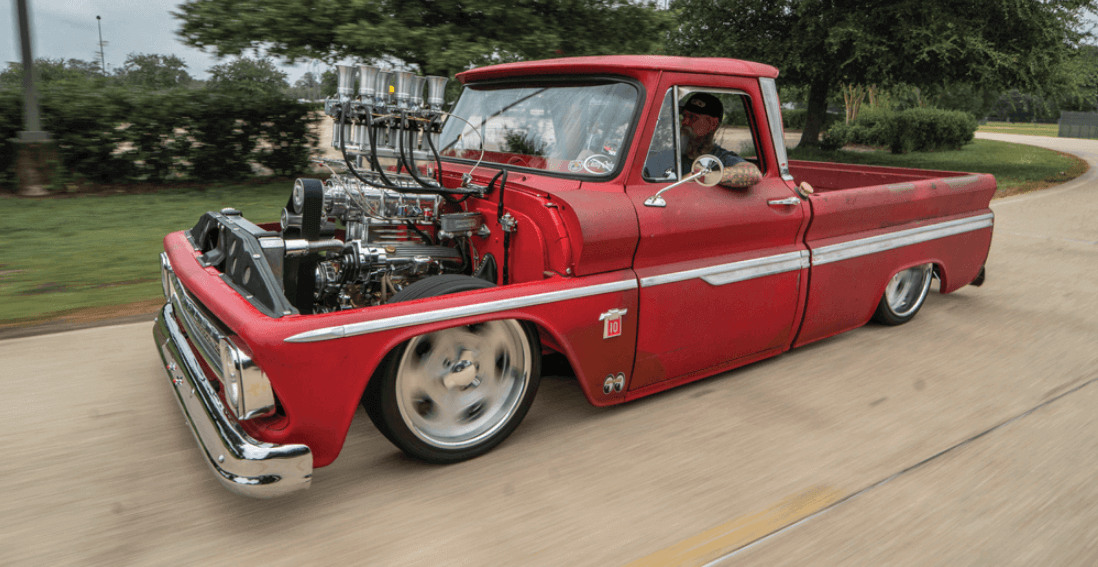
“JUST BECAUSE” IS AS VALID A REASON AS ANY TO BUILD A TRUCK. As often as there’s an inspiring or otherwise touching story behind a build, it’s also just as common that the truck itself is the only reason needed. When you look at the beautiful, classic lines of a 1960-66 Chevy/GMC, for instance, you can’t help but want to dive right in. Case in point: Dave Schneider’s ’65 Chevy C-10 Pickup.
Don’t like to read? We narrated it for you! Click Play!

The truck was an eBay find about a dozen years ago, and Dave’s sole intention was to have a cool daily driver to tool around town in. Things were fine and dandy for a while; that is until the engine blew one day. It’s a friggin’ terrible predicament to be in, but, boy, does it open up a bunch of options when you have to pull an engine and stare at an empty bay.
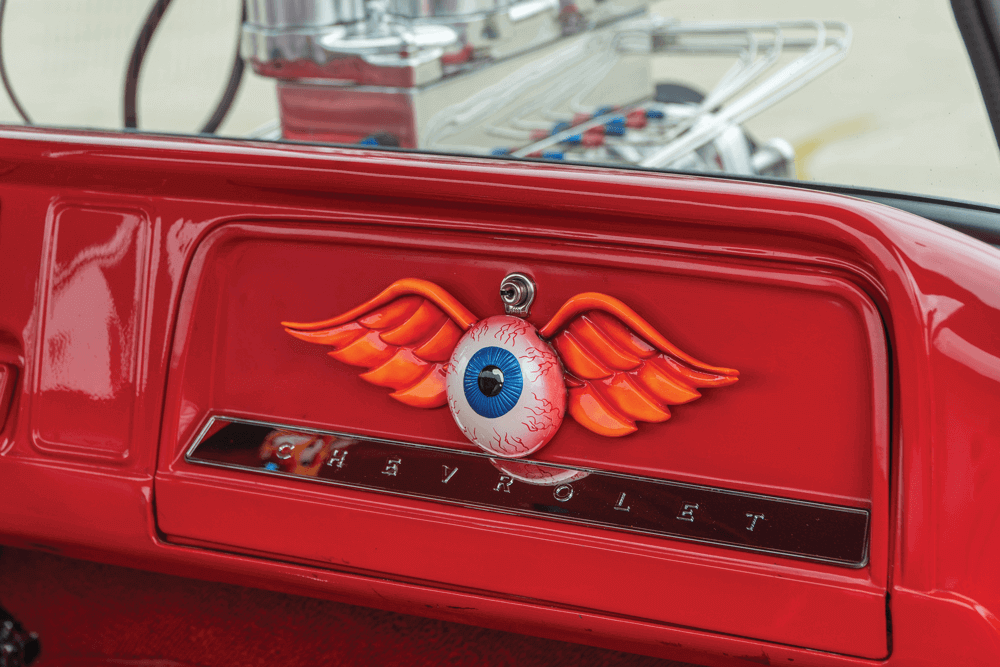
This sudden turn of events meant a lot of downtime, but it gave Dave time to come up with some pretty wild ideas. All he needed was some space in the garage and plenty of money. The first part came easy; the rest came in time.
A BUILT TURBO 350 KEEPS THINGS SIMPLE IN THE SHIFTING DEPARTMENT, ALTHOUGH WE’RE CURIOUS ABOUT HOW WELL IT’LL HOLD UP OVER TIME, ESPECIALLY WHEN DAVE HITS THE NITROUS TRIGGER.”
Dave ordered a Scott’s Hot Rods front suspension/ cross-member kit to update the front end with air ride, so it only made sense to treat the back as well. There were plenty of kits for him to choose from, but in the end, Porterbuilt won out with its Extreme Dropmember rear setup, which helped put the C-10 flat on its belly, thanks to its included Firestone airbags and step notch.

After all that, though, Dave still hadn’t dealt with the engine situation that caused him to tear the truck apart in the first place. He decided to pick up a new 350 crate engine and call it a day.

If you’re wondering why the words you just read don’t quite match the photos, there’s a logical explanation. Yes, Dave just replaced the old engine with an internally strengthened 350 engine and a set of stainless headers. The induction setup, however, is a whole other story.
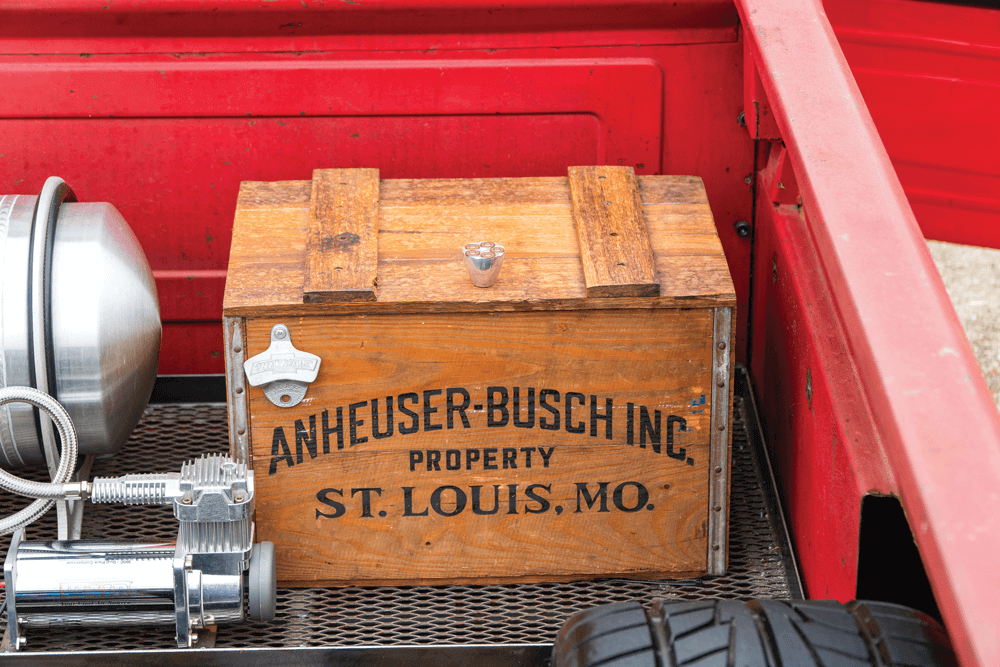
While Dave was already going against the grain by sticking with a classic Chevy small-block (weird, right?), it’s the Hampton supercharger topped by a half-dozen Stromberg 97 carbs that really stands out. Include a decent shot of nitrous oxide to squeeze tons more air into the engine, and you quickly understand that Dave’s mighty mouse means business. In fact, when we first saw Dave’s truck, we wondered if it was an Australian burnout that had been transplanted to U.S. soil.

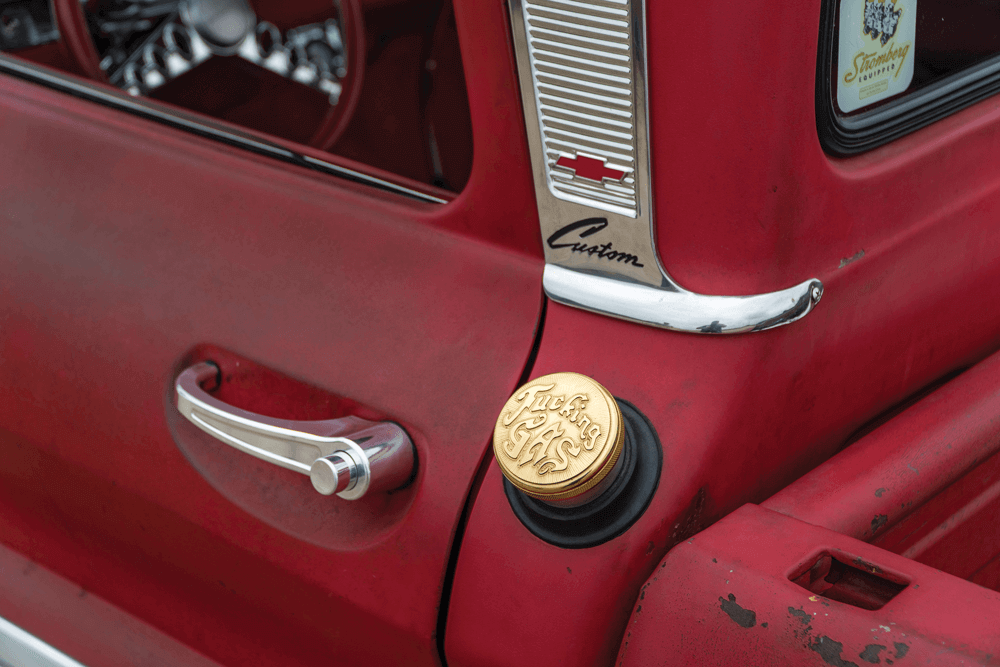
A built Turbo 350 keeps things simple in the shifting department, although we’re curious about how well it’ll hold up over time, especially when Dave hits the nitrous trigger. At least he has Wilwood brakes hidden behind each Colorado Custom Sugar City wheel to slow the truck down after hitting Ludicrous Speed.
NO RADIO FOR DAVE BECAUSE HE WOULDN’T BE ABLE TO HEAR IT OVER THE SOUND OF THE SUPERCHARGER AND CARBS ANYWAY. OVERALL, WE THINK HE’S MADE SOME PRETTY SOLID—IF NOT A LITTLE CRAZY—CHOICES FOR HIS TRUCK, BUT THAT’S THE BEAUTY OF DOING IT ‘JUST BECAUSE.’”
The interior of Dave’s red Chevy definitely has some early drag-racing influence, which makes sense considering the general hot-rodiness of the Strombergs and early GMC-based blower sitting directly in front of the cab. The Speedway Motors bomber-style seats, which were made a bit comfier thanks to padding stitched by The Custom Stitching Company, really stand out as the centerpiece of the interior. The rest is pure hot rod as well, with a 14-inch steering wheel, Moon tachometer and even a vintage-style aftermarket turn signal assembly mounted on the original steering column.
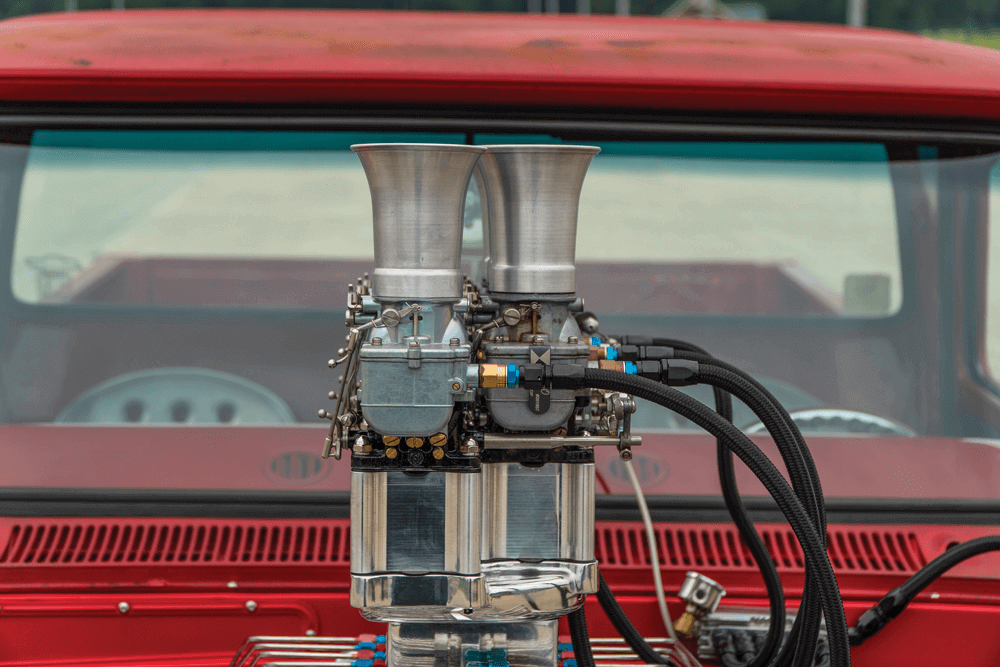

And guess what? No radio for Dave because he wouldn’t be able to hear it over the sound of the supercharger and carbs anyway. Overall, we think he’s made some pretty solid—if not a little crazy—choices for his truck, but that’s the beauty of doing it “just because.”
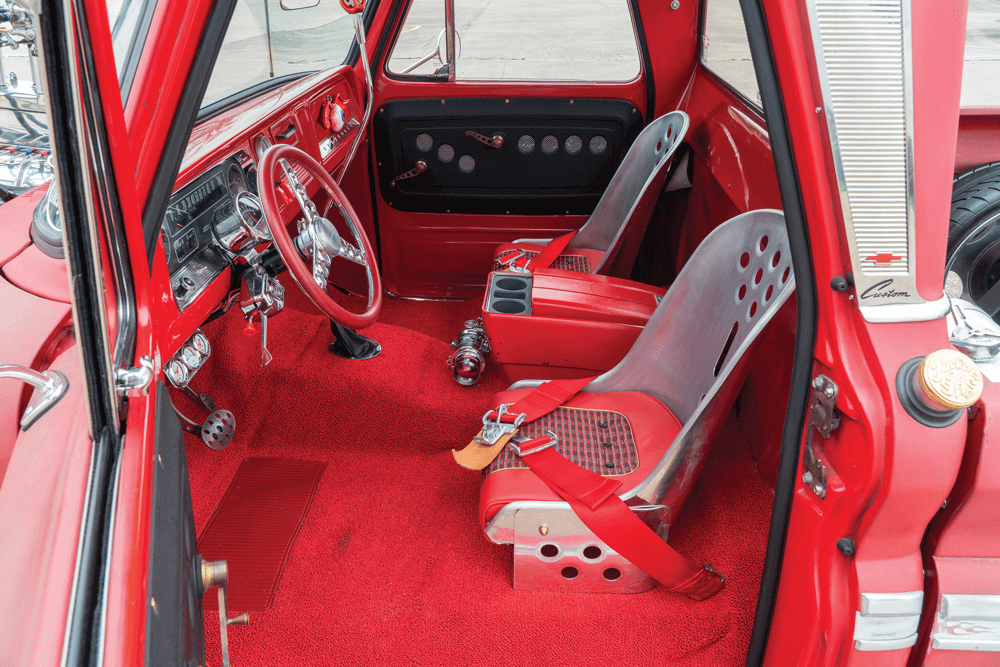
TRUCK SPECS
OWNER
Dave Schneider
’65 Chevy C-10 Pickup
Mint Hill, NC
Relaxed Atmosphere
CHASSIS & SUSPENSION
WHEELS & TIRES
ENGINE
BODY & PAINT
INTERIOR & STEREO
What significant changes occurred in the 1965 Chevrolet C10 model compared to the previous year?
The 1965 Chevrolet C10 may have retained much of its exterior styling from the previous year due to a major redesign just prior, but it introduced several noteworthy updates that distinguished it from earlier models.
These updates made the 1965 Chevrolet C10 not just a carryover model, but a vehicle with enhanced driving comfort and usability features, setting a new standard for future iterations.
What are the different conditions available for the ’65 Chevy C10 Pickup?
When considering a 1965 Chevrolet C10, you’ll find the vehicles in a range of conditions, each impacting value and restoration potential. Here are the common categories:
Each condition tier affects not just price, but also the extent and type of work required if you’re planning any restoration or customization projects. Consider your needs and capabilities before making a choice!
What is the price range for a 1965 Chevy C10 Truck?
When considering the purchase of a 1965 Chevrolet C10, the price can vary significantly based on factors such as condition, originality, and modifications. Here’s a breakdown of the typical price range you might encounter:
This wide range offers plenty of choices, catering to both budget-conscious buyers and enthusiasts seeking top-tier models.
What are the different price categories for purchasing a 1965 Chevrolet C10?
If you’re on the market for a 1965 Chevrolet C10, you’ll find that prices can vary significantly. Here’s a breakdown of the different price categories you might encounter:
Additionally, you have the flexibility to define a custom price range based on your specific budget.
Consider these categories to help guide your purchasing decision based on budget and preferred level of restoration.
What transmission options are available for the 1965 Chevrolet C10?
A built Turbo 350 keeps things simple in the shifting department, although we’re curious about how well it’ll hold up over time, especially when Dave hits the nitrous trigger. For those exploring transmission options, the 1965 Chevrolet C10 offers variety to suit different driving preferences.
These choices cater to both the purists who cherish manual control and those who prefer the ease of an automatic. The Turbo 350’s simplicity is aligned with the spirit of this classic truck, yet the durability in high-performance situations, like nitrous boosts, remains a topic of interest.
How many speeds does each type of transmission have?
The automatic transmission features 9 speeds, while the manual transmission comes with 6 speeds.
What types of transmissions are available for the vehicle?
The vehicle offers both automatic and manual transmission options.
What new features were introduced in the ’65 Chevy C10 Pickup?
“DAVE LEFT THINGS NICE AND AIRY BETWEEN THE BEDSIDES, CHOOSING TO SHOW OFF ALL OF THE WORK THAT WENT INTO GETTING THE TRUCK AS LOW AS IT IS. IT’S EASY TO SPOT THE PORTERBUILT FRAME AND SUSPENSION COMPONENTS, BUT EVEN MORE OBVIOUS ARE THE TWIN NOS BOTTLES THAT FEED THE BLOWN ENGINE.”
In 1965, the Chevrolet C10 took a significant leap forward by introducing air conditioning as an option, marking a new era of comfort for drivers. This innovation was just one of the many ways the C10 was evolving to meet the demands of its enthusiasts. The combination of modern amenities with Dave’s masterful custom touches turns this classic truck into a true standout.
From its sleek, lowered stance to the powerful enhancements under the hood, every element of this C10 tells a story of both heritage and innovation. The attention to detail in the customization mirrors the same pioneering spirit that first brought air conditioning to the model, bridging past advancements with contemporary craftsmanship.
What changes or additions were made to the 1965 Chevrolet C10 compared to previous models?
The significant addition to the 1965 Chevrolet C10 was the option to include air conditioning, a feature not previously available in earlier models.
What new features were introduced in the ’65 Chevy C10 Pickup?
The 1965 Chevrolet C10 introduced air conditioning as an available option for the first time.
Share Link